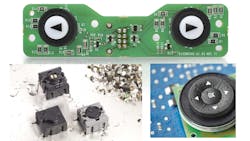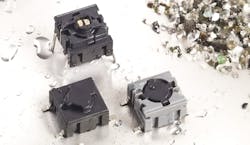Tactile Switches Simplify and Improve the User Interface Experience
Touchscreens and flat panel touch systems abound through consumer, commercial, industrial, medical and other markets. They are used in mobile devices, automotive interiors and many other types of appliances and equipment. Certainly, touchscreens are a useful way to present information and enable a variety of input.
However, there are cases where a more “physical” approach is desired or required. In many situations, electromechanical buttons are a preferred operator interface solution because they provide a clearly understood interface for essential functions. They also provide positive motion and tactile feedback, ensuring users experience a satisfactory interaction with equipment.
Among a wide array of options, tactile (tact) switches designed for printed circuit board (PCB) mounting provide an excellent balance among size, modularity and versatility. They are sealed and designed for long operating lifetimes under a variety of environmental conditions, making them the best choice for many commercial and industrial applications.
Choices for the Look and Feel
Tact switches, sometimes called board-mounted pushbuttons, are a leading category of operator interface for many types of digital systems. Depending on the application, a main or secondary circuit board is often mounted just below an operator control panel area. Instead of installing more standalone buttons and switches, and then wiring them to a remote board, it can be more efficient to design and support a circuit board in an orientation that can directly accept board-mounted pushbuttons. Tact switches can be equally or more robust than the surfaces onto which they are mounted.
The form factor of tact switches is very low profile (Fig. 1). In addition, while more traditional buttons are typically round or square, tact switches are available in those shapes—but also in many other styles—such as oval, arrow-shaped, rectangle and more. The shape of the button can actually convey some information regarding the function, making this an important feature.
READ MORE: Understanding the Increased Demand for Industrial Switches in Food and Beverage Plants
Key caps for tact switches come in a wide range of colors and textures and they are available with legends and industry-standard icon markings, so designers can create easy-to-recognize layouts for users. Some are even available with glow-in-the-dark features.
Designers can choose from an extensive list of standard styles, or they can even work with a supplier to create custom types and different materials to provide a personal touch. For example, the buttons can be made to look like wood, leather, carbon fiber or other materials so that they blend or contrast with the mounting surface.
Caps should be thermoplastic or polycarbonate to best withstand high temperatures and extreme operating forces. In some cases, designers may choose to use an overall foil overlay, or a flexible over-molded surface skin, arranged over one or more tact switches without caps. This is a good solution providing even more protection, along with a smoother overall feel and appearance. And, even if the surface fails, the underlying switches can continue to operate.
One specialized arrangement useful for many applications is a “navigational” configuration, consisting of four up/down/left/right arrows and a central “OK” or “enter” button. This style can be contained in one overall device, or it can be created from five individual devices.
Tactile Switch Basics
A basic tact switch body is around 13/13/16 mm in height/width/depth, but some versions can be as small as 8/8/4 (Fig. 2). The switch has a plunger or pad on top to accept and interface with the cap, which activates an internal metallic dome mechanism arranged with electrical contacts. Plunger mechanical operation is usually momentary, but some are available as latch/unlatch type.
READ MORE: The Right Lubricant Brings Out the Best in Electrical Switches
Actuation will have a specified force value, and sometimes different forces are available for a given type of device. These devices are available as IP67 for protection against dust and temporary liquid immersion, making them ideal for marine applications and anywhere that liquids might be present.
Specifiers should look for robust switches designed for a lifetime numbered in the millions of actuations. Depending on the size and model, cycle lifetimes can be 1, 3, 10 or more million. In fact, some switches are built such that an adult can stand on them, with the switch still functioning normally afterwards.
One or two contacts (1-pole and 2-pole) are common for tact switches, in various combinations of normally-open (NO) and normally-closed (NC). These contacts should be designed to resist “bounce,” as this condition could otherwise introduce erroneous operation of digital control systems. For applications with safety concerns, users should look for switches that can offer combined simultaneous NC/NO operation, where the digital controller can monitor alternate contacts to ensure proper switch function.
Electrical connections on the back/bottom of the switch can be through-hole (TH) pins, designed to be inserted through a PCB and soldered into place for a solid mechanical and electrical connection. For the most compact needs, some tact switches are available as surface-mount devices (SMD) so they can be soldered right onto the top of a PCB.
Non-illuminated tact switches are suitable for many applications and integrated chip-LED versions are available to backlight the cap and markings when this functionality is needed.
Quality and Elegance
OEMs and electronics manufacturers looking for best performance and reliability, with a dash of elegance, should consider choosing high-quality tact switches from proven suppliers for their designs (Fig. 3).
Some of the most suitable industries and applications include:
- Consumer goods. Push-to-talk radio buttons, control panels for consumer electronics and handheld remote controls are a good fit for tact switches. Illuminated versions confirm the operating status.
- Commercial/industrial devices. The barcode scanner gun at every store is just one example of electronics requiring user inputs, such as a trigger button to be used—and abused—countless times each day. Boats, buses and many other vehicles need user input for auxiliary functions. Tact switches are low cost but feature high durability, making them a good fit for these types of applications.
- Off-highway equipment. Agricultural, construction site and many other types of equipment use control panels and joysticks, each of which often need numerous operator interface functions. Tact switches are easily arrayed on control panels, and can even fit on joystick surfaces to provide a tactile operator interface that can be arranged logically for users.
- Food, beverage, medical. Cookers, liquid dispensers and controls for medical devices are all subject to high temperatures, process liquids and cleaning fluids. Tact switches, especially when configured under a graphic overlay, provide the required user information and can resist conditions ranging from hot oil to cleaning solutions.
Designers should work with a tact switch supplier demonstrating longstanding experience in the field, with an expansive portfolio to meet most any need. When standard components just won’t work, the supplier should have the ability to respond to custom requirements for tact switches and the ability to build complete configurations on PCBs to provide a full panel solution.
Suppliers should manufacture devices and components in-house for best quality control, with rigorous testing programs and 100% in-line testing during production. The right tact switch partner will help any OEM or manufacturer create the high-performance and cost-effective solutions they need for their applications.
Chris Do Vale is the senior component product manager for APEM, Inc.



